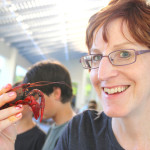Jon Bell, a professor in Louisiana State University's AgCenter Department of Food Science, has found himself at the center of the Gulf of Mexico oil spill controversy. As a trainer with the National Oceanic and Atmospheric Administration's Sea Grant program, Bell is responsible for educating seafood processors on sensory tests to detect oil-tainted seafood. Some consumers — and even a few seafood professionals — don't believe that sniff tests are enough to detect oil.
Bell recently talked to SeafoodSource about the testing and Louisiana's development of a premium seafood marketing program.
Blank: How did you end up in the middle of the issues surrounding the Gulf oil spill?
Bell: I was director of quality assurance for Chicken of the Sea in California, but I accepted this job at LSU three months ago. I had worked on a project for the shrimp industry in Louisiana, to help them deal with the economics of imports, for five years before I left Louisiana in 2008.
What are consumers' current perceptions of Gulf seafood?
I remember the oil well gushing on CNN all the time, and the image of oiled birds. Those are the two main images that the general public has for this oil spill. Also, when they preliminarily closed the waters to fishing, consumers became more fearful, without really understanding. I just moved from California, and people there are afraid to eat Gulf seafood. There are still seafood companies that are really concerned about staying solvent.
Explain how Sea Grant is training seafood processors and others to do "smell tests" to detect oil in seafood.
We work with people all over, from Alaska to Texas. We put together a short training program on how to meet the requirements [of testing for oil in seafood]. They must document that it was harvested from open waters, document the HACCP (Hazard Analysis Critical Control Point) plan that was used, then add a sensory evaluation if they want to. This is something they are going to do anyway, to see if there is decomposition or contamination from motor oil or other substances. Even during the training, we would have processors say, "Your nose is not going to be able to find oil." They would detect samples that had oil at very low levels, and they realized they could do it themselves. The next level [of education] is buyers and consumers. I have done presentations for groups of sports fishermen and chefs. We give them the background about how this has been studied — sensory analysis is a curriculum in universities.
How are you helping to develop a premium marketing program for Louisiana seafood?
I am to do outreach to fishermen and program development. Let's get Louisiana shrimp to be a premium program, and make it a program that is going to have sustainability and traceability. Shrimp is a commodity market, and we are not the low-cost producer because wild product has its challenges. The goal of this program is to try to take this product that has specific characteristics and get it out to customers who are willing to pay more for a premium product. You have to have standards to do that. There will be scientific standards that ensure we meet Food and Drug Administration regulations and there will be traceability and certification. This is not going to be for the whole industry. We are revising the final standards documents, and it needs to be vetted by the different stakeholders. Our goal is to have it in place by the next shrimp season.






